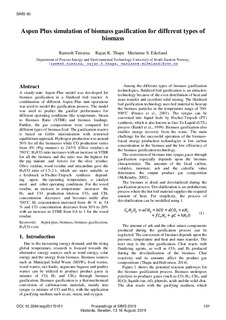| dc.contributor.author | Timsina, Ramesh | |
| dc.contributor.author | Thapa, Rajan Kumar | |
| dc.contributor.author | Eikeland, Marianne Sørflaten | |
| dc.date.accessioned | 2020-02-05T09:11:01Z | |
| dc.date.available | 2020-02-05T09:11:01Z | |
| dc.date.created | 2020-01-31T11:07:46Z | |
| dc.date.issued | 2019 | |
| dc.identifier.citation | Linköping Electronic Conference Proceedings. 2019, 170, 151-157. | nb_NO |
| dc.identifier.issn | 1650-3686 | |
| dc.identifier.uri | http://hdl.handle.net/11250/2639710 | |
| dc.description.abstract | A steady-state Aspen Plus model was developed for biomass gasification in a fluidized bed reactor. A combination of different Aspen Plus unit operations was used to model the gasification process. The model was used to predict the gasifier performance for different operating conditions like temperature, Steam to Biomass Ratio (STBR) and biomass loadings. Further, the gas compositions were compared for different types of biomass feed. The gasification reactor is based on Gibbs minimization with restricted equilibrium approach. Hydrogen production was around 50% for all the biomasses while CO production varies from 8% (Pig manure) to 24.5% (Olive residue) at 700°C. H2/CO ratio increases with an increase in STBR for all the biomass and the ratio was the highest for the pig manure and lowest for the olive residue. Olive residue, wood residue and miscanthus gave the H2/CO ratio of 1.5-2.1, which are more suitable as a feedstock in Fischer-Tropsch synthesis depending upon the operating temperature, a catalyst used and other operating conditions. For the wood residue, an increase in temperature increases the H2 and CO production whereas CO2 and CH4 concentration decreases and becomes stable after 700°C. H2 concentration increased from 46 % to 54 % and CO concentration decreases from 30% to 20% with an increase in STBR from 0.6 to 1 for the wood residue. | nb_NO |
| dc.language.iso | eng | nb_NO |
| dc.rights | Navngivelse-Ikkekommersiell 4.0 Internasjonal | * |
| dc.rights.uri | http://creativecommons.org/licenses/by-nc/4.0/deed.no | * |
| dc.title | Aspen Plus simulation of biomass gasification for different types of biomass | nb_NO |
| dc.type | Journal article | nb_NO |
| dc.type | Peer reviewed | nb_NO |
| dc.description.version | publishedVersion | nb_NO |
| dc.source.pagenumber | 151-157 | nb_NO |
| dc.source.volume | 170 | nb_NO |
| dc.source.journal | Linköping Electronic Conference Proceedings | nb_NO |
| dc.identifier.doi | https://doi.org/10.3384/ecp20170151 | |
| dc.identifier.cristin | 1787832 | |
| cristin.unitcode | 222,58,3,0 | |
| cristin.unitname | Institutt for prosess-, energi- og miljøteknologi | |
| cristin.ispublished | true | |
| cristin.fulltext | postprint | |
| cristin.qualitycode | 1 | |

